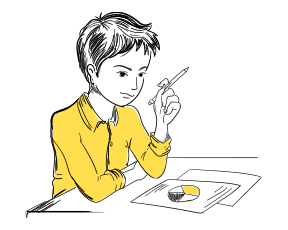The occurrence of learning disabilities (LD) in India is estimated to be at minimum 10-12% of the school-aged population. This implies that in an average Indian classroom, there are a minimum of four students with LD.
Learning disabilities and learning difficulties are often used interchangeably, but they refer to two different conditions that affect an individual’s ability to learn. A learning disability is a neurological disorder that affects how a person receives, processes, and stores information. These difficulties can stem from environmental, genetic, and neurological factors. Learning difficulty, on the other hand, is a condition that affects a person’s ability to acquire knowledge and skills in a particular area, such as reading or math. The most common learning disabilities are dyslexia, dyscalculia, and dysgraphia. Dyslexia is a learning disability that affects a person’s ability to read, write, and spell. It is caused by a difference in the way the brain processes language. Dyscalculia is a learning disability that affects a person’s ability to understand and work with numbers. Dysgraphia is a learning disability that affects a person’s ability to write coherently and neatly.
Individuals with learning problems may have trouble with attention, memory, organization, social interaction,etc. They may also have difficulty with time management, planning, and decision-making. These difficulties can have a significant impact on an individual’s emotional well being effecting their self-confidence and self-esteem.

Learning difficulty
Learning difficulties, also known as “hidden disabilities,” can go unnoticed as individuals affected may appear to have average or above-average intelligence and may not receive timely support. Challenges arise from a gap between an individual’s potential and their ability to process information, impacting verbal learning (reading, writing, language) and nonverbal learning (visual processing, abstract concepts). Around 20% of those with learning difficulties also struggle with concentration. It’s important to understand that these difficulties are unrelated to effort or intelligence, and with proper support, individuals can overcome them and excel academically. Emotional and social support is crucial due to potential frustration, anxiety, and low self-esteem. Sometimes, comorbid conditions like ADHD and ASD can pose additional learning challenges, but learning difficulties do not affect overall intelligence or cognitive abilities.
Similarities and differences
While learning disabilities and learning difficulties share some similarities, they are two distinct conditions. The primary difference between the two is that learning disabilities are neurological disorders that affect how the brain processes information, while learning difficulties are conditions that affect a person’s ability to learn in a particular area.
Both learning disabilities and learning difficulties can impact an individual’s academic performance, social interactions, and emotional well-being. Individuals with learning disabilities may require specialized support and accommodations to succeed academically and socially. It is crucial for educators, parents, and healthcare professionals to understand the distinctions between learning disabilities and learning difficulties. This understanding enables them to provide the necessary support and accommodations tailored to the specific needs of individuals with these conditions.
Empowering Abilities: Effective Interventions for LD
There are various interventions that can support individuals with learning difficulties and disabilities. Firstly, these interventions can be divided into three main categories: educational, behavioral, and technological.
- Educational interventions:
- Educational Therapy: It involves assessing the child’s potential and work on areas of improvement using individualized education plans (IEPs). It focuses on the cognition, perception, emotion and academic growth.
- Remedial therapy: This involves providing additional support for students to catch up with their peers in areas of difficulty. It’s main focus is on academics.
- Multisensory instruction: This involves using a multi-sensory approach to help students learn. For example, using hands-on activities, visual aids, and auditory cues can be effective.
- Behavioral interventions:
- Positive reinforcement: This involves rewarding desired behaviors, such as completing a task or paying attention in class.
- Behavioral contracts: This involves setting clear expectations and consequences for behavior.
- Self-monitoring: This involves having the student monitor their own behavior and progress.
- Therapeutic interventions:
- Occupational therapy: This involves working with an occupational therapist to improve fine motor skills, hand-eye coordination, and other skills related to daily living.
- Speech therapy: This involves working with a speech therapist to improve communication skills, such as speaking, listening, and understanding language.
- Counseling or psycho-therapy: This involves working with a psychologists or counselor to address emotional and behavioral issues that may be impacting the student’s ability to learn.
It is important to note that the specific intervention used will depend on the individual’s needs and the severity of their learning problems. A comprehensive evaluation by a qualified professional is necessary to determine the appropriate interventions for everyone.

